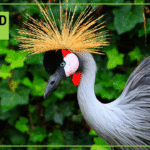Monitor Lizards: Nature’s Clever and Clawed Reptiles
Meet the Monitor Lizards
With their long claws, flickering tongues, and ancient presence, monitor lizards might look like something out of a storybook — but they’re very real and endlessly fascinating. These reptiles are known for their intelligence, surprising behaviors, and ability to thrive in some of the harshest places on Earth.
From tree-dwelling climbers to desert explorers, let’s get to know the mighty monitors.
Species of Monitor Lizards
Monitor lizards come in all shapes and sizes — from tree-dwelling climbers to powerful land-dwelling giants. With over 80 species in the family, here are a few of the most fascinating and well-known examples.

Komodo Dragon (Varanus komodoensis)
The largest of all monitors, Komodo dragons are found on a few Indonesian islands. They can grow up to 10 feet long and are known for their powerful limbs, rough skin, and sharp intelligence.
👉 Read more about Komodo Dragons | 🎥 Watch the video

Savannah Monitor (Varanus exanthematicus)
Native to sub-Saharan Africa, this sturdy, ground-dwelling monitor has a strong build and a curious personality. Often kept in captivity, they’re known for forming bonds with keepers.

Asian Water Monitor (Varanus salvator)
One of the fastest-growing lizard species, these semi-aquatic reptiles are common in Southeast Asia and are strong swimmers that can live near human settlements.

Green Tree Monitor (Varanus prasinus)
These bright green climbers live in the rainforests of New Guinea and use their prehensile tails to move through the treetops.
Habitat
Monitor lizards are found across Africa, Asia, and Australia — and in a few scattered regions beyond. Depending on the species, they may live in:
- Tropical rainforests
- Arid deserts and savannas
- Mangroves, swamps, and wetlands
- Rocky outcrops and forests
Some, like the water monitor, even adapt to human-altered environments.
Diet
All monitor lizards are carnivores. While their diet varies by size and location, they commonly eat:
- Insects and other invertebrates
- Fish and amphibians
- Small mammals and reptiles
- Eggs, carrion, and occasionally birds
They use their sharp claws and flickering tongues to find and handle food, often with great precision.
Share On Social:
Mating & Raising Young
Monitor lizards typically mate once per year. After courtship rituals — which may include circling, tail flicking, or grappling — females lay clutches of eggs in burrows, rotting logs, or termite mounds. The number of eggs varies, with Komodo dragons laying around 15–30 at a time.
Most species do not provide parental care, but females may guard the nest for a short period. Hatchlings are born fully independent.





Fun Facts
- Some monitor lizards can stand — or even run — on two legs!
- They smell with their tongue — some can detect scents from over 6 miles away!
- They can solve puzzles, count, and even recognize individual humans.
- When threatened, they inflate their bodies to look bigger.
- Their tail is strong enough to whip attackers — and it hurts!
About Monitor Lizards
Scientific Family: Varanidae
Number of Species: Over 80 recognized species
Habitat: Forests, savannas, wetlands, deserts
Diet: Carnivorous
Lifespan: 8–30+ years (varies by species)
Unique Traits: Forked tongue, keen intelligence, powerful claws
Social Structure: Mostly solitary
Fun Fact: Komodo dragons can grow up to 10 feet long!
Why We Love Them
Monitor lizards are so much more than sharp claws and scaly skin — they’re incredibly clever, surprisingly adaptable, and deeply fascinating to observe. With some species forming bonds in captivity and others solving challenges in the wild, these reptiles remind us that brainpower isn’t just a mammal thing.
Their diversity, mystery, and ancient presence make them unforgettable members of the animal kingdom.












Conclusion
From ancient deserts to tropical forests, monitor lizards continue to thrive in some of the world’s wildest places — often outsmarting expectations along the way. Their brains, boldness, and variety make them one of the most fascinating reptile families on the planet.
Whether they’re climbing trees, solving puzzles, or calmly patrolling a riverbank, monitor lizards are living proof that nature still has plenty of surprises.
🦎💚 Stay curious — and keep exploring more amazing animals right here at BearBunk
Did you learn something new? Share this post to your favorite board or group and help others fall in love with the wild world of reptiles.
Watch the Video on YouTube:
Monitor Lizards Nature’s Ancient Giants!
Learn more about:
Reptiles, Grasslands Animals, Australian Wildlife, Asian Wildlife, and Smart Animals






Leave a Reply